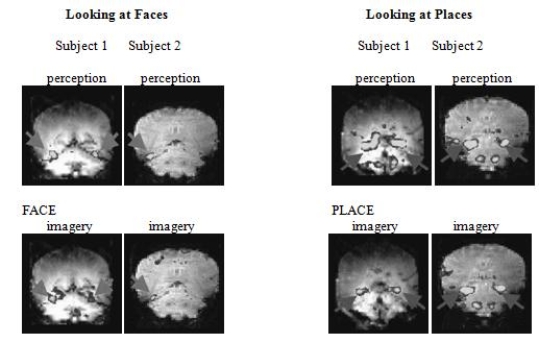Shown here are the fMRIs of the brain activity in two participants whilethey looked at photographs of familiar faces and places (top row-perception) or imagined the same pictures (bottom row-imagery) .According to the Focus on Neuroscience box, "Seeing Faces and Places inthe Mind's Eye," what do these fMRIs demonstrate? 
A) The fusiform facial area is activated when either looking at familiar faces or imagining them, and the parahippocampal place area is activated when either looking at familiar places or imagining them.
B) Totally different brain areas are active when participants look at objects (familiar faces or places) compared to when they imagine the same objects.
C) There is virtually no brain activity in the fusiform facial area or the parahippocampal place area when participants are looking at familiar faces or places (perception) but very high levels when the participants are imagining familiar faces or places (imagery) .
D) There is a very high level of brain activity in the fusiform facial area and the parahippocampal place area when participants are looking at familiar faces or places (perception) but very low levels when the participants are imagining familiar faces or places (imagery) .
Correct Answer:
Verified
Q12: Who is this person and for what
Q13: The psychologist in this picture is administering
Q17: Which of the following is NOT true
Q206: The psychological process that involves manipulating mental
Q211: How we use our cognitive abilities and
Q218: Thinking often involves the manipulation of two
Q221: The mental categories we have formed to
Q222: A mental representation of objects or events
Q223: Mental images:
A) can involve any of the
Q233: Joseph is trying to select a new
Unlock this Answer For Free Now!
View this answer and more for free by performing one of the following actions

Scan the QR code to install the App and get 2 free unlocks

Unlock quizzes for free by uploading documents